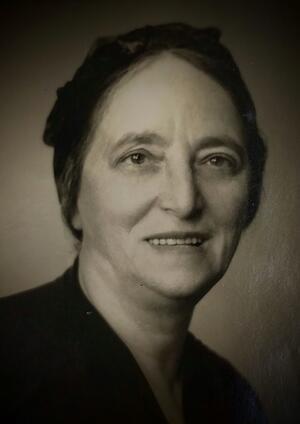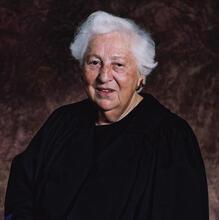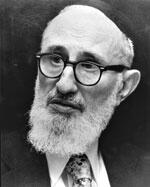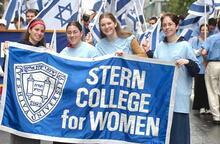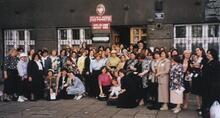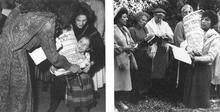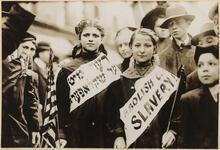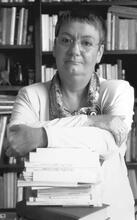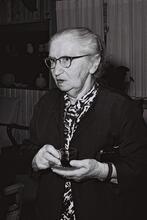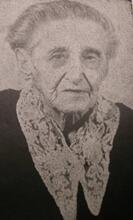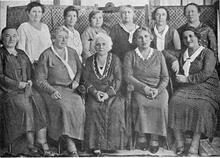Chana Shpitzer
Chana Shpitzer was an important figure in the field of Jewish education for girls in Jerusalem in the early twentieth century. After World War I, she opened a school for girls in Jerusalem with Hebrew as the language of instruction. She was a firm believer in single-sex education and her goal was for her students to develop academically, religiously, and practically. She turned at first to Agudat Israel for support, but they disagreed with her desire for girls’ schooling and with the idea of Hebrew as a modern spoken language. She instead was funded by the Mizrachi, a religious Zionist movement, and was able to develop a complex of institutions serving 1500 girls in Jerusalem. Her school was known for its emphasis on academic achievement, and almost all graduates found gainful employment.
Although not well-known outside Jerusalem, Chana Shpitzer was an interesting figure in the history of Israeli education and a pioneer in the field of Jewish education for girls.
Early Life & Family
On the side of her mother, Chaya Michal (d. 1917), Shpitzer was a fifth-generation descendant of one of the oldest and most significant Ashkenazi families in Jerusalem—the Rivlins, disciples of the Vilna Gaon (Elijah ben Solomon Zalman, 1720–1797). The family of her father, Rabbi Zevi Asher Kahana-Schapira (1873– 1938), came from Cracow in Poland. Her maternal grandfather and brothers were active in establishing important charitable and educational institutions in Jerusalem. The family was related by marriage to Abraham Isaac Kook, the Ashkenazi Chief Rabbi of Palestine.
Shpitzer’s father was an “enlightened rabbi,” hiring private tutors who taught his daughter together with his sons. From early on, Chana developed a reputation among her friends as a serious student and a leader. Around 1900 she married Chayim Shpitzer, the son of Shmuel Zangwill Shpitzer, a benefactor of many charitable causes in the religious community. The couple had seven children: Avraham (d. 1953), Shelomo, Yonah, Ya’akov (d. 1977) and Shoshanah (1917-2010); two died in childhood.
Opening her First School
When World War I broke out and the economic situation of the Jewish community in Palestine prior to the establishment of the State of Israel. "Old Yishuv" refers to the Jewish community prior to 1882; "New Yishuv" to that following 1882.Yishuv deteriorated, Chana’s husband set out for the United States to look for work, leaving her with five young children. (Although he occasionally returned for brief periods, Chana was essentially on her own for most of her adult life.) Even before he left, Chana had begun to teach the girls in her neighborhood to read and write, but eventually she decided to open a real school for girls. The very Orthodox circles in Jerusalem did not want to send their daughters to schools where they were taught foreign languages; in contrast to the bilingual Evelina de Rothschild school, Shpitzer’s school taught mainly in Hebrew, and only the older girls were taught English. Her goal was that her pupils should learn and be able to become independent and self-sufficient members of society, as well as loyal daughters of their people.
At first, Shpitzer turned to Agudat Israel (World Organization of Orthodox Jews, founded in 1912 in Poland) for support for her project. She was convinced that the language of instruction in her new school ought to be Hebrew. The leadership of Agudat Israel disagreed both with her desire for girls’ schooling and with her conception of Hebrew as a modern spoken language. (It should be noted that this was even before the establishment of the Bais Ya’akov schools in Poland in 1917.) At this point, Shpitzer turned to the religious Zionists for help. For many years, her enterprise was supported by the Mizrachi (religious Zionist movement founded 1902). In 1919 the school became an official institution of Mizrachi’s education department. The extreme ultra-Orthodox authorities placed economic sanctions on families who sent their daughters to her school, denying them the Pre-Zionist era system whereby Diaspora Jews financed the Jewish communities in the holy cities of Erez Israel.halukkah funds (money raised by Lit. (Greek) "dispersion." The Jewish community, and its areas of residence, outside Erez Israel.Diaspora Jews to support the Yishuv) to which they were entitled.
The School Expands
Despite a stormy relationship between Shpitzer and the authorities of the Mizrachi (on personal rather than ideological grounds), the funding she received from them helped her to develop her small school of seventy students located in the Bukharan Quarter of Jerusalem into a complex of institutions encompassing some 1500 girls. These institutions included several branches of the elementary school, a high school with both academic and commercial courses of study, a store in which the girls sold various arts and crafts items they had made, and a youth movement for girls. Shpitzer was a firm believer in single-sex education, feeling that coeducation often did not allow for the full development of the female students. In her school she tried to develop the “feminine” side of the students by stressing, for example, the emotional and aesthetic aspects of the school; at the same time, the high school curriculum included study of the Lit. "teaching," "study," or "learning." A compilation of the commentary and discussions of the amora'im on the Mishnah. When not specified, "Talmud" refers to the Babylonian Talmud.Talmud. She felt it was important for all the girls to know how to cook, sew, and manage their own accounts. Shpitzer was a natural educator who integrated in her school many new ideas, like a school newspaper, theater performances,and so on. A good deal of thought was devoted to the kind of education necessary to prepare young women for their future lives.
Chana Shpitzer was essentially self-taught, acquiring fluency in Hebrew but lacking formal academic or professional qualifications. She was a very powerful and dominant figure in the school. She herself taught Pirkei Avot (Avot, a tractate in the Codification of basic Jewish Oral Law; edited and arranged by R. Judah ha-Nasi c. 200 C.E.Mishnah) and frequently sat in on classes being taught by other teachers. Her school was known for its emphasis on order, cleanliness, and hygiene, as well as academic achievements. One of the sources of pride in the school was that almost all of the graduates found gainful employment.
After Shpitzer’s death, her daughter Shoshanah Raziel (widow of the Irgun Zeva’i Le’ummi commander David Raziel) took over as principal. Under Raziel’s leadership, one of the branches of the elementary school became coeducational. It is known today as the Yehudah Ha-Levi School in the Katamon neighborhood of Jerusalem. The remaining branches continued to function until the early 1970s.
Weissman, Deborah. “Chana Shpitzer: A Leader in Education.” In A Women in Jerusalem: Gender, Society and Religion, edited by Tova Cohen, 79-85. 2002, pp. 79- 85. (Hebrew)

